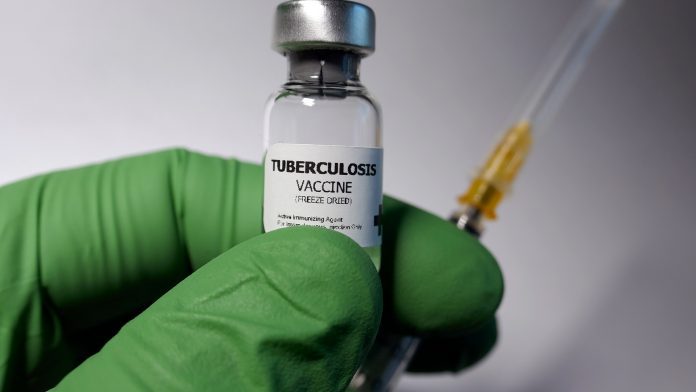
Researchers have found a new way to enhance the tuberculosis vaccine by adding an antibody that can improve long-term effectiveness.
Tuberculosis is a bacterial infection that is spread via the inhalation of tiny droplets from the coughs or sneezes of an infected person. The BCG tuberculosis vaccine offers protection against the infection and is recommended on the NHS for babies, children, and adults under the age of 35 who are at risk of catching it.
The researchers from Texas Biomedical Research Institute found that blocking a key molecule when administering the tuberculosis vaccine improves long-term protection against the disease in mice. This groundbreaking development could potentially save millions of lives if the results apply to humans too.
“We are very excited that we can reverse BCG’s waning effectiveness by combining it with a host-directed therapy into one dose, which makes it very practical for the clinic,” said Joanne Turner, PhD, Texas Biomed’s Executive Vice President, Research, and senior paper author.
The study was published in the Journal of Immunology.
Tuberculosis vaccine: a long-lasting solution
Turner has a long history investigating the role of the tuberculosis vaccine, more specifically, focussing on the role of the molecule called interleukin-10 (IL-10) on the disease. IL-10 typically helps reduce excessive inflammation during infection, but through numerous studies, Turner and her team have found IL-10 does more harm than good in tuberculosis, definitively showing it driving the tuberculosis infection.
Previously, Turner and her team blocked the IL-10 at different times, including:
- During the infection,
- late into infection,
- the first three weeks during infection and,
- then blocking the IL-10 completely.
The researchers found that all variations appeared to improve tuberculosis control and longer survival. However, in the current study, the team focused on what happens if they temporarily block IL-10 before infection occurs at the same time as giving the tuberculosis vaccine.
The researchers combined the existing tuberculosis vaccine with an antibody that blocks IL-10 activity for around one week. Since the antibody targets the host, not the pathogen, that becomes a ‘host-directed therapy’. The team gave this mixture to mice in one dose, waited six weeks to ensure the IL-10 blocker was no longer present and the tuberculosis vaccine protection had been generated and then exposed the mice to tuberculosis.
The study found that those mice controlled the tuberculosis infection for nearly a year, which is significant for mice with normal lifespans of about two years. On the other hand, mice given only the tuberculosis vaccine lost control of the infection within two months and showed significant inflammation and damage in the lungs. Remarkably, the mice given the vaccine/IL-10 blocker had higher levels of various long-term memory immune cells, which are critical for ongoing infection control.
“This shows that the early development of an immune response is key for controlling TB infection in the long run and that IL-10 inhibits the development of that long-term immunity,” Turner said. “But by briefly blocking IL-10 at the same time as giving the vaccine, it allows the vaccine and immune system to do their jobs, creating those long-lasting memory immune cells.”
Using mouse models
IL-10 has been somewhat dismissed as playing a significant role in tuberculosis, regardless of the fact it has been detected in humans with the disease. Yet this conclusion was made in the most common strain of research mouse, which is resistant to tuberculosis and does not produce much IL-10.
The researchers investigated a different mouse strain, called CBA/J, which is more susceptible to tuberculosis. They found by working with these mice, they could link together IL-10’s role and what happened to it when it was blocked. To definitively show the molecule’s function, researchers will knock out the gene that codes for that molecule. Turner bred the CBA/J IL-10 knock-out mice, which required several years of effort, and since 2011 the mice have been instrumental in proving IL-10 drives tuberculosis. These mice can even form human-like granulomas, which are cellular aggregates that form around the bacteria to prevent it from spreading.
“We only saw that because we were working in a different mouse strain than the standard laboratory mouse strain,” Turner said. “It is gratifying that those knock-out mice we developed are available for other researchers to work with. Diversity in animal models is important to understand the commonalities across species that help us better understand human diseases.”










